
|
|

September 15, 2006
WHIC 1460, Rochester, NY
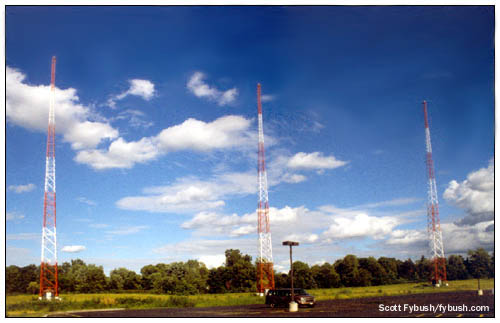 For
the next couple of weeks, we're interrupting our ongoing look
at the sites featured in Tower Site Calendar 2007 for a few installments
of breaking news.
For
the next couple of weeks, we're interrupting our ongoing look
at the sites featured in Tower Site Calendar 2007 for a few installments
of breaking news.
(We're also doing a lot of traveling, so if there's some disruption to the schedule, our apologies in advance!)
This week, it's a site particularly close to our heart - the three-tower array on 1460 kHz in the town of Brighton, N.Y. that was the very first directional array we ever paid close attention to. It wasn't difficult - the station, then known as WAXC, was right next to your editor's elementary school playground, and its tower beacons could be seen out my bedroom window every night.
One of the earliest Tower Site of the Week installments was a look at 1460 (by then WWWG) and its nearby neighbors in Brighton. Even then, it was clear that the writing was on the wall for at least some of those arrays, as we wrote: Someday, it's possible to imagine that some of these sites won't even exist, should WXXI carry out its move to Mendon and WWWG lose the lease on its towers. If that day ever comes to pass, it'll be a mixed blessing here in NERW-land.
Within the last year or so, it became clear that that day would indeed soon pass, as 1460 (now WHIC) did lose the lease and move to a diplex on the nearby WROC (950) site. Even so, it was a shock to the system when we turned the corner out of our street last Sunday (Sept. 10) and found that the 1460 site had been levelled.
"There's a hole in the sky," said one of our local engineering friends after he saw the towerless site. We agree - but the best we can do is to present the most comprehensive memorial we can offer to the six decades of AM radio at 1850 South Winton Road.
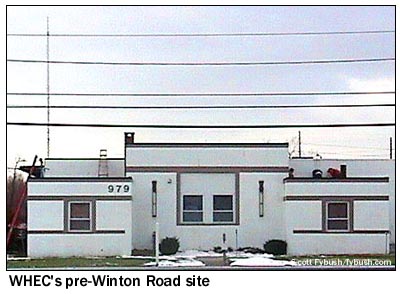 |
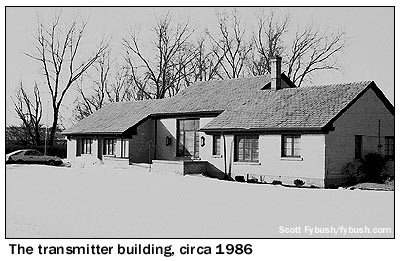 |
The heritage of Rochester's 1460 actually long predates the Winton Road site. It can be traced back to the earliest days of radio here, when a young engineer named Lawrence Hickson built the city's first radio station, WHQ, for the Rochester Times-Union newspaper. WHQ lasted only a few months in 1922, replaced later that year by a much more successful operation, WHAM. Hickson went on to build station WABO (later absorbed into WHAM) - and in 1925, his Hickson Electric Company put WHEC on the air from the Rochester Savings Bank building downtown.
WHEC quickly became one of the city's most successful stations, and within a few years it moved its transmitter to the west side of town, at 979 Mount Read Boulevard, erecting a self-supporting tower and raising power to 1000 watts.
In 1947, WHEC moved again, increasing power to 5000 watts (non-directional by day, directional at night) from a state-of-the-art facility on Winton Road. Its new building was a larger version of the Mount Read transmitter building (which survives today as the front office of a machining company), and out back were three 205-foot self-supporting towers.
At the time, the site was an excellent choice for serving the Rochester area. WHEC had to protect co-channel stations in Albany, Harrisburg and Columbus, so the only logical place to put the nighttime transmitter was south of the city. The Winton Road site was far enough south to serve the entire market in 1947, and WHEC enjoyed several more decades as a successful CBS Radio outlet before its star began to fade.
Longtime owner Gannett decided to exit the radio business in Rochester in the early seventies, and on January 5, 1972, WHEC radio left the air for good. Its new owners transformed the station into a rocking top-40 signal, WAXC, and enjoyed a few more years as a major player in the market. By the end of the seventies, the writing was on the wall. FM was growing in impact, and suburban sprawl had pushed many potential listeners outside the reach of WAXC's night signal.
In 1978, WAXC became WWWG, "3WG Radio 15," and the next year the rock gave way to religion. The studios and offices moved from the city to take up residence in the Winton Road transmitter building, and that's where they were when your editor first stopped in in the early eighties. Do I wish I had pictures of the old transmitter, behind a glass door in the lobby? You bet I do.
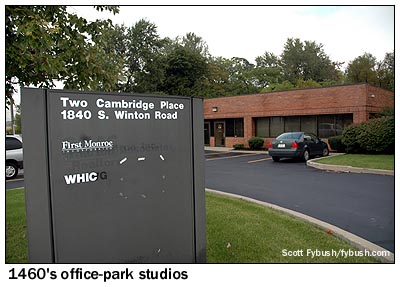 |
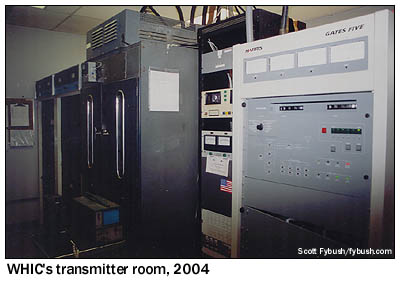 |
The once-rural neighborhood around the 1460 site was already a crowded place by the time the station became "3WG." A school had been built behind the station in the late fifties, and residential construction sprouted in the old farmland east of the site over the next few decades. In the sixties, the Route 47 expressway was built just south of the site, ending at Winton Road, and by 1980 it had become I-590, bringing thousands of cars past the 1460 towers every day.
All that traffic brought still more development, making the WWWG property too valuable to stay the way it was. In the late eighties, the old transmitter/studio building was demolished. In its place rose the Cambridge Place office development - one big office building, a smaller one with space for WWWG's new studio and transmitter room, and eventually a road right through the site of the old building, leading back across the creek to yet another office building and parking lot that were built almost to the edge of the three-tower array.
We visited the office-park studio in 2004, just as the sale of WWWG to a Catholic broadcaster, Holy Family Communications, had been completed. The station had just become WHIC, and most of the WWWG offices and studios had been emptied, since the broadcasts were now coming from a studio near Buffalo. Only the old Gates MW-5, the newer Gates Five and the very old phasor survived, cranking away in the back room.
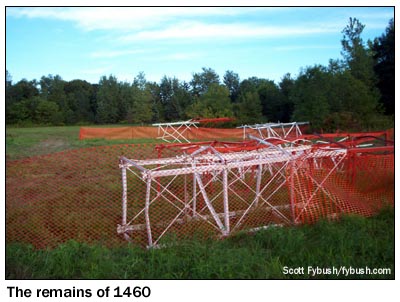 |
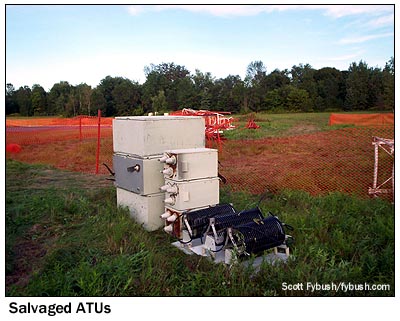 |
In 2005, WHIC applied to move from the Winton Road site to the four-tower WROC (950) site a mile or so to the west. The proposed new signal will use three of WROC's four towers, with 4500 watts (non-directional) by day and 3000 watts at night. While waiting to build that facility, though, WHIC's lease on the Winton Road property finally ran out, and the end came swiftly.
In August 2006, WHIC began operating from the WROC site under special temporary authority, using 4500 watts by day and 750 watts at night, operating non-directionally from the easternmost tower in the 950 array. It moved its transmitter equipment out of Winton Road and into a garage at the WROC transmitter building. (As you can see in the picture below, only the Gates Five and some STL equipment is connected at the moment; the old MW-5 and the phasor are simply being stored there.)
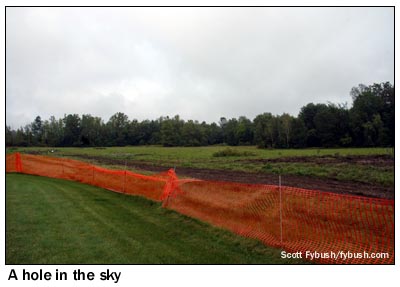 |
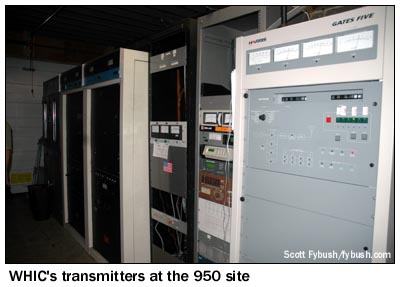 |
And it received a demolition permit from the town, specifying that the towers had to be removed on a Sunday morning, with no advance publicity and no spectators.
 It happened early
on the morning of September 10, 2006. I'm told tower climbers
scaled each tower, tied a rope to the top, then climbed back
down, cut two legs of each tower, and pulled them down.
It happened early
on the morning of September 10, 2006. I'm told tower climbers
scaled each tower, tied a rope to the top, then climbed back
down, cut two legs of each tower, and pulled them down.
By the time I arrived that night, the remains of the towers were stacked at one corner of the field, with only the concrete bases left in the field. By the end of the week, even those had been ripped up and removed, along with the tower steel.
Soon enough, this land, too, will no doubt become an office building, with nothing left but some fading memories of six decades of radio on South Winton Road, a few fading pictures in the Site of the Week archives, and a big hole in the sky where those tower beacons used to blink all night long.
The Tower Site Calendar 2007 is here! Be one of the first to receive your copy - order today at the Fybush.com Store!
- Previous Site of the Week: KGO, San Francisco, CA
- Next Week: WOR Tower Demolition, Lyndhurst, N.J.
- Site of the Week INDEX!
- How can you help support Site of the Week? Click here!
- Submit your suggestions for a future Site of the Week!
